Respiratory disease in weanlings (Proceedings)
Lower respiratory disease is a common problem in foals under 8 months of age.
Lower respiratory disease is a common problem in foals under 8 months of age. The most common causes of lower respiratory disease in weanlings include 1) opportunistic bacterial pneumonia (Streptococcus zooepidemicus is the most common), 2) Rhodococcus equi pneumonia, 3) bronchointerstitial pneumonia and 4) parasitic pneumonia.
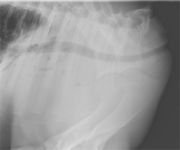
Bacterial pneumonia
Bacterial pneumonia
Bacterial pneumonia: Opportunistic organisms include Strep zooepidemicus, Strep pneumoniae, Actinobacillus spp, Pasturella spp, Bordetella bronchoseptica,Klebsiella ssp, and E. coli. Foals develop bacterial pneumonia secondary to parasitic pulmonary migration, viral respiratory disease, and stress (overcrowding, transport and weaning).
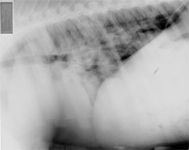
R. equi
Clinical signs: will vary on severity. Fever, depression, anorexia, and bilateral purulent nasal discharge. Advanced cases can appear very similar to cases of R. equi or interstitial pneumonia (dyspnea, respiratory distress and cyanosis).
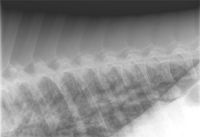
Interstitial pneumonia
Diagnostics: Thoracic radiographs can be very helpful. Thoracic radiographs may help determine the likelihood of routine bacterial pneumonia from R. equi and interstitial pneumonia. Thoracic radiographs of bacterial pneumonia usually reveal consolidation of the cranioventral lungs. R. equi often demonstrates perihilar abscessation and alveolization. Interstitial pneumonia appears as diffuse interstitial pneumonia of the caudodoral lungs.

US â bacterial pneumonia
Ultrasound of the thorax can also be useful to identify pleural effusion and peripheral consolidation. Ventral lung consolidation can occur with bacterial pneumonia. Rhodococcus is be characterized with peripheral abscessation. Ultrasound will not detect lung pathology that is deep to overlying aerated lung. Ultrasound examination of interstitial pneumonia can range from a normal pleural border and to excessive comet tails. Severe consolidation is not usually consistent with interstitial pneumonia
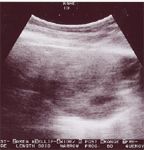
US- R equi
Transtracheal wash is indicated to appropriately work up the pneumonia (including cytology).
Treatment: Initially a broad spectrum antibiotic (including antibiotics specific for Strep spp). Bordetella bronchoseptica may be more difficult to treat. B. bronchoseptica is a B-lactamase producer, which results in bacterial overgrowth due to death of penicillin-sensitive organisms. Foals may show an initial improvement with antibiotic therapy, followed by deterioration of clinical signs. Aminoglycosides are the treatment of choice (gentamicin and amikacin). The organism lives anchored to the epithelial surface of the airway. In some cases neubulization with gentamicin may be necessary to provide direct deliver of the antibiotic to the airway.
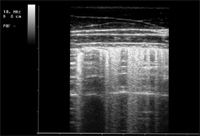
US- interstitial pneumonia
Rhodococcus Equi
R. equi is not the most common cause of pneumonia in foals. However, R. equi pneumonia causes life-threatening pneumonia in foals 1-5 months of age. Foals acquire the infection within the first 2 weeks of life by inhalation of contaminated soil.
Clinical signs: The clinical signs include a slowly progressive respiratory infection that often presents as acute respiratory distress. Cough and nasal discharge are not always present. Auscultation is usually abnormal (crackles and wheezes). Some foals will have evidence of immune-mediated polyarthritis and immune mediated uveitis. Intestinal and extrapumonary infections with R. equi do occur
Diagnostics: CBC and serum chemistry- usually reveal a significant leukocytosis, hyperfibrinogenemia, and hyperglobinemia. Thoracic ultrasound and radiographs reveal peripheral lung consolidation and perihilar abscessation. A transtracheal wash is necessary to provide a definitive diagnosis. Cytology reveals intracellular coccobacilli. Culture is recommended. A PCR is available, but false positive results are possible.
Treatment: Current recommendations include: azithromycin and rifampin (5-10 mg/kg PO q 12 hours). The azithromycin is administered at 10 mg/kg PO q 24 hours until clinical signs stabilize, than is followed by every other day administration (until resolution of clinical signs). Clarithromycin can be used instead of azithromycin.
Prevention: Prevention on endemic farms aimed at preventing infection (first 2 weeks of life), and early diagnosis of R. equi pneumonia. Recommendations to prevent infection: 1) reduce dust, plant more grass, ovoid over-crowding 2) hyperimmune plasma 1 L first 24-48 hours of life, followed by a second liter approximately 25 days of age 3) azithromycin 10 mg/kg PO every other day for 14 days (in combination with plasma). Diagnosis of early respiratory cases: 1) daily temperatures on all foals; 2) physical examination/auscultation twice a week; 3) blood work (repeated every 7-14 days); and 4) in some cases thoracic ultrasound.
Bronchointerstitial pneumonia (interstitial pneumonia)
Interstitial pneumonia is an important cause of acute respiratory distress in foals 1-8 months of age. Clinical signs can appear very similar to R equi pneumonia or severe bronchopneumonia. The incidence is sporadic and cause is unknown.
Clinical signs: Clinical signs include acute respiratory distress, cyanosis, tachycardia, fever, and sudden death. Thoracic auscultation reveals crackles and wheezes. In addition, anorexia, depression, cough and nasal discharge can be present. Foals may have a history of mild respiratory disease prior to the development of severe clinical signs.
Diagnostics: CBC and chemistry- can vary, and can be similar to R equi (severe leukocytosis and hyperfibrinogenemia). Thoracic radiographs provide the most useful information, revealing diffuse to caudodorsal distributed interstitial and bronchointerstitial pulmonary opacities. With advanced disease, there can be patches of coalescing alveolar nodular pattern with air bronchograms. Culture of a transtracheal wash usually reveals neutrophilic inflammation. Culture is often positive, but not one consistent organism (R. equi is not grown).
Treatment: The exact etiology is unknown, and there is no specific therapy. The treatment plan includes: 1) broad spectrum antibiotics; and 2) anti-inflammatory drugs. In severe cases bronchodilators, nasal oxygen, and supportive care is recommended. In severe cases corticosteroids (dexamethasone 0.1 mg/kg q 24 hr) may be beneficial. NSAID provide additional anti-inflammatory effects, and are better antipyretics. Bronchodilators and intranasal oxygen is often necessary. Omeprazole is recommended is indicated due to the severity of the disease and use of anti-inflammatory medications.
Parasitic pneumonia
Parasites migration can play a role in development of bacterial pneumonia in foals. Pulmonary migration of roundworms (Parascaris equroum) occurs 7 -14 days after larval ingestion, but 10-12 weeks are required to detect a patent infection. There is documentation of ivermectin resistance to some populations of ascarids in horses. Donkeys are the reservoir for Dictyocaulus arnfieldii, which results in pulmonary inflammation in horses.
Clinical signs: Can vary in severity
Diagnostics: Some foals may have a slight eosinophila. A transtracheal wash will reveal an eosinophilc inflammation
Treatment: Recommend deworming with either fenbendazole or strongid. Could consider following up with fenbendazole at 10 mg/kg q 5 days.
Newsletter
From exam room tips to practice management insights, get trusted veterinary news delivered straight to your inbox—subscribe to dvm360.